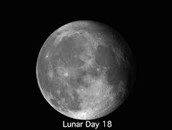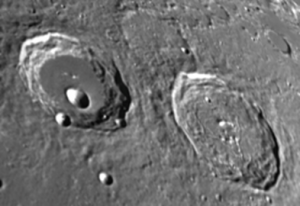The week of September 25 – October 1 takes us from Lunar Day 11 to Day 18. This week we will highlight the moon craters Hercules and Atlas, located in the NE quadrant of the Field Map and viewable on Sunday evening.
 Hercules and Atlas1: [NE/E13-14; L=39°E] Just east of Lacus Mortis (the “Lake of Death”) are two splendid craters, Hercules and Atlas. They have been described variously as “noble, magnificent, spectacular, scarcely surpassed.” Although in Greek mythology Hercules and Atlas were contemporaries, the craters named after them appeared at widely different times. You should be able to tell at a glance which crater is older (Make a decision before looking at the footnote.)2 There is a large simple crater on the floor of Hercules. Can you tell if it is bowl-shaped or does it have a flat floor?
Hercules and Atlas1: [NE/E13-14; L=39°E] Just east of Lacus Mortis (the “Lake of Death”) are two splendid craters, Hercules and Atlas. They have been described variously as “noble, magnificent, spectacular, scarcely surpassed.” Although in Greek mythology Hercules and Atlas were contemporaries, the craters named after them appeared at widely different times. You should be able to tell at a glance which crater is older (Make a decision before looking at the footnote.)2 There is a large simple crater on the floor of Hercules. Can you tell if it is bowl-shaped or does it have a flat floor?
 Atlas has central peaks, rilles, a hummocky floor, and two small dark haloes known as lunar pyroclastic deposits. It is also one of the Moon’s many examples of a floor-fractured crater (FFC).
Atlas has central peaks, rilles, a hummocky floor, and two small dark haloes known as lunar pyroclastic deposits. It is also one of the Moon’s many examples of a floor-fractured crater (FFC).
Hercules has multiple terraces, and if you look very closely at it under the right lighting you will notice two small bumps that are reminiscent of the crater Cassini, which you will encounter on Day 7 [E10]. These tiny bumps, located just north of the large internal crater Hercules G, are actually the tops of enormous mountains that have been almost entirely inundated by abundant lava flows. Hercules is also the site of reported lunar transient phenomena (LTP’s).
Did you notice that both Atlas and Hercules have blankets of surrounding ejecta, known as a glacis?
OF ADDITIONAL INTEREST IN SPACE:
On Thursday, Neptune is 1.4°N of the moon.
Full moon is on Friday.
1 Hercules/Atlas: These two craters are paired because of the legend which entwined them both. Atlas was one of the Titans of Greek mythology whose punishment for siding in a war against Zeus was to hold the celestial sphere on his shoulders (some versions say it was the Earth).
To propitiate for having killed his wife and children in a fit of temporary insanity induced by Hera, Hercules was assigned twelve labors that were so difficult they seemed impossible. One of these labors was to steal three golden apples that Hera had given to Zeus as a wedding present. Hercules learned that the secret to getting the apples was to send Atlas to do the job. Atlas agreed to do so, providing Hercules took over the task of holding up the celestial sphere while he was gone. Atlas recovered the apples and fully intended to leave Hercules holding his burden forever, but Hercules tricked him into holding the sphere “just for a moment” while he got some padding for his shoulders. In what was possibly the first reported stereotype of “all brawn and no brain”, Atlas agreed and Hercules fled the scene with the apples.
2 Because the walls are more deteriorated and its interior contains more small craters, Hercules is the older crater.
======================
It is highly recommended that you get a copy of Sky and Telescope’s Field Map of the Moon, the very finest Moon map available for use at the telescope. It is available for $10.95 at www.skyandtelescope.com and on Amazon. All features mentioned in this blog will be keyed to the grid on the Field Map and will look like this: Plato: [NW/D9]
Credits:
Courtesy of Gray Photography of Corpus Christi, Texas
Lunar photos: NASA / USGS / BMDO / LROC / ASU / DLR / LOLA / Moon Globe. Used by permission
- Trio of Moon Craters with Distinct Personalities - April 22, 2024
- Hippalus Rilles on the Moon - April 15, 2024
- Moon Crater Janssen: How New Moon Craters are Superimposed on Top of Older Craters - April 8, 2024